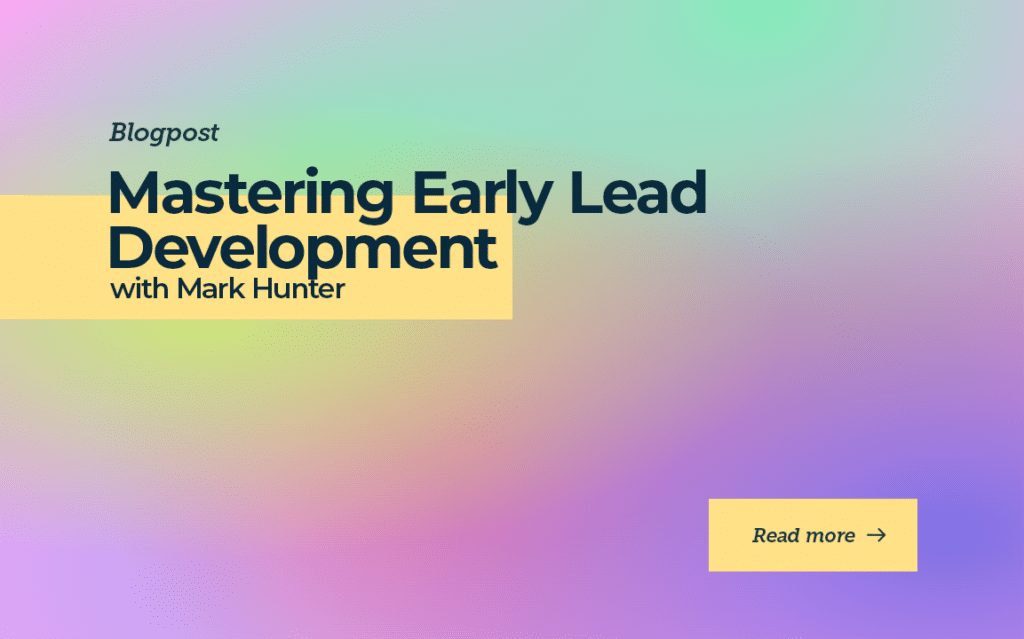Mastering Early Lead Development with Mark Hunter

Effective sales conversations are the cornerstone of business growth, especially for startups navigating early success and expansion challenges.
A renowned sales expert, Mark Hunter, offers invaluable insights on transforming sales conversations to achieve better outcomes. Sales professionals can enhance engagement and conversion rates by profoundly understanding the prospect’s business, identifying key challenges, and proposing tailored solutions.
This guide distills Hunter’s wisdom into actionable steps to help founders and sales teams improve their sales processes and drive sustainable growth.
Understanding the Founder’s Dilemma
Early success can be exhilarating for founders but often brings unforeseen challenges. Mark Hunter, known as the Sales Hunter, aptly describes this phase as the “founder’s dilemma.”
Founders, driven by initial success, may prematurely assume their product can scale indefinitely. The critical first step is to dissect the reasons behind early revenue to avoid potential pitfalls.
Critical Insight: Founders must focus on understanding why customers buy their product, emphasizing the outcome rather than the product itself.
The Importance of Outcome Over Product
The actual value of a product lies in its outcome, not in its creation itself. Founders often mistakenly believe that their creation is the key driver of sales.
However, success hinges on the benefits and solutions the product provides to customers. This outcome-oriented approach helps identify and target the right customer segments.
Actionable Tip: Segment your market based on the outcomes your product creates and focus your efforts on those segments to maximize impact.

Focusing on Specific Customer Segments
A common mistake among founders is the “spray and pray” approach, where they attempt to target a broad market.
Instead, it’s crucial to concentrate on specific customer segments that have shown interest and have benefited from the product. This laser-focused strategy ensures efficient use of limited resources and increases the chances of sustainable growth.
Strategy: Identify the key attributes and reasons behind your early customers’ purchases and create a focused marketing and sales strategy around those insights.
Avoiding the Trap of Overextension
Hunter emphasizes the risk of overextension when companies receive funding. It’s tempting to ramp up marketing efforts and pursue various opportunities simultaneously, but this can lead to resource depletion without meaningful returns.
Advice: Stay disciplined with your marketing budget and sales efforts. Prioritize activities that align with your core customer segment and proven outcomes.
Differentiation and Market Fit
Entering an established market with a slightly better product is often not enough.
The new product must offer significant improvements or solutions to critical problems to entice customers to switch from established brands. This requires a deep understanding of the market dynamics and customer pain points.
Example: If your product is entering a market dominated by established players like Campbell Soup in the food industry, it must provide a compelling reason for customers to switch.
Strategic Patience: Land and Expand
A “land and expand” approach can be practical for startups with better but not revolutionary solutions. This involves securing small initial deals and gradually expanding within those accounts. While this strategy takes time, it can lead to stable, long-term growth.
Challenge: This approach may not align with investors’ rapid growth expectations, requiring clear communication and strategic patience.
Insight: Investors often seek quick returns, but sustainable growth sometimes necessitates a slower, more deliberate expansion strategy.
The 1,000 Day Clock
Mark introduces the concept of the “1,000 Day Clock,” emphasizing the importance of a startup’s first three years. This period is crucial for defining the company’s path and making pivotal growth and market strategy decisions.
Key Insight: Treat the first 1,000 days as a decisive period to establish a strong foundation and direction for your startup.
Identifying the First Vertical
One of the biggest challenges for startups is finding the right market segment to focus on.
Hunter suggests a systematic approach:
- Market Testing: During the beta phase, start by testing your product across multiple segments (5-6 different areas).
- Focus on Outcomes: Pay attention to your product’s outcomes for customers, not just its features. This helps you understand which segment benefits the most from your solution.
- Bet Wisely: Make informed bets on the segment that shows the most promise but keep some resources in reserve to allow for necessary pivots.
Explanation: When testing your product, it’s not just about whether it can be implemented or installed but what positive change it brings to the customer. By focusing on the outcomes, you can identify which market segment truly values your product and will likely provide sustainable growth.
Differentiating Market Response from Sales Execution
Founders often face the challenge of understanding whether a market’s lack of interest is due to the market itself or its sales approach.
Hunter explains that ineffective sales processes often stem from poor messaging and positioning.
- Refine Your Messaging: Ensure that your sales pitch highlights the benefits and outcomes rather than just listing features.
- Proper Positioning: Tailor your approach to different levels within the target companies to address their specific concerns and priorities.
Explanation: It’s crucial to convey the right message to the right audience. For example, C-suite executives care about strategic benefits and ROI, while mid-level managers focus on operational improvements.
Crafting your message to suit these different perspectives can significantly impact your sales success.
Segmenting Messaging for Different Stakeholders
Hunter provides a practical example of a company that uses different messages for various levels within an organization:
- C-Suite: Emphasize the strategic advantages and return on investment.
- Senior Management: Highlight how the product supports departmental goals and initiatives.
- Mid-Level Managers: Focus on operational efficiencies and process improvements.
- Production Floor: Address concerns about job security and ease of use.
Explanation: Different stakeholders have different priorities and concerns. By segmenting your messaging, you can ensure that each group understands how your product will benefit them specifically, which can facilitate a smoother decision-making process.
Avoiding Over-Demonstration in Sales
A common pitfall in sales is overwhelming potential customers with too much information during a demo.
Hunter advises a more focused approach:
- Listen First: Before jumping into the demo, understand your prospect’s specific needs and pain points.
- Targeted Demos: Only demonstrate the features directly relevant to the customer’s identified problems.
- Prevent Overwhelming: Too much information can lead to decision paralysis, causing the prospect to back away from committing.
Explanation: A demo should showcase how your product solves the customer’s issues. Keeping it relevant and focused increases the chances of moving forward in the sales process.
Practical Tips for Founders
- Prioritize Outcomes: Focus on the customer outcomes rather than the product itself.
- Tailored Communication: Develop customized messages for different levels within target organizations.
- Strategic Patience: Adopt a “land and expand” approach for gradual, sustainable growth.
- Effective Resource Allocation: Consider your limited resources and place calculated bets on the most promising segments.
By following these insights and strategies, founders can better navigate the complexities of early sales efforts, ensuring a focused and effective approach to growth.
Guide to Effective Sales Conversations
Step 1: Avoid Pre-Scripted Presentations
Insight: Generic, pre-scripted presentations fail to engage prospects meaningfully.
- Actionable Tip: Customize each presentation to address your customer’s specific needs. Avoid stock presentations that don’t address each prospect’s unique situation.
Example: Instead of using a generic demo deck, prepare slides highlighting different features based on the customer’s specific challenges and needs.
Step 2: Embrace Simplicity in Demos
Insight: Simplified demos, such as PowerPoint slides, can be more effective than live software demonstrations, prone to technical issues.
- Actionable Tip: Keep your initial presentation straightforward. Use a few key slides to convey your product’s core benefits and functionalities without risking technical glitches.
Example: Create a concise PowerPoint with 5-7 slides that outline your product’s primary benefits, focusing on how it solves specific problems for the customer.
Step 3: Create Curiosity and Anticipation
Insight: Building anticipation keeps prospects engaged and eager to learn more.
- Actionable Tip: Start with your product’s most compelling aspects and gradually reveal additional features. Avoid overwhelming your prospect with too much information at once.
Example: In your initial meeting, introduce the key feature that addresses the customer’s main pain point. As the customer expresses more interest, save detailed demonstrations and additional features for subsequent meetings.
Step 4: Foster Meaningful Conversations
Insight: Engaging customers in meaningful conversations helps uncover their true needs and challenges.
- Actionable Tip: Ask open-ended questions encouraging the prospect to discuss their business challenges and goals. Listen actively and respond thoughtfully.
Example: Instead of jumping into a demo, ask, “What are the biggest challenges your team currently faces?” Follow up with, “How do you envision overcoming these challenges?” Use their responses to tailor your pitch.
Step 5: Avoid Over-Demonstration
Insight: Overloading the prospect with too much information can lead to decision paralysis.
- Actionable Tip: During demos, show only the features that directly address the customer’s specific problems.
Example: If a customer’s primary concern is data security, focus your demo on your product’s security features rather than showing every functionality.
Step 6: Follow-Up with Strategic Questions
Insight: Strategic follow-up questions can keep the conversation going and deepen engagement.
- Actionable Tip: After your initial presentation, follow up with questions that prompt further discussion about the customer’s needs and how your product can meet them.
Example: After a demo, ask, “What specific challenges do you think our solution could help you solve?” This encourages the prospect to think critically about how your product fits into their operations.
By following these steps, founders can enhance their sales conversations, making them more engaging, effective, and customer-centric. This approach improves the chances of closing deals and fosters stronger relationships with potential customers.
Transforming Sales Conversations
Mark shares valuable insights on conducting effective sales conversations that lead to better outcomes.
Sales professionals can enhance engagement and conversion rates by understanding the prospect’s business, identifying key challenges, and proposing tailored solutions.
Understanding Your Prospect’s Business
One of the foundational steps in any sales conversation is gaining a deep understanding of the prospect’s business. This involves asking open-ended questions to uncover the specific challenges they are facing.
Example Questions:
- “Tell me a little bit about the business you’re in.”
- “What are some of the challenges you’re currently facing?”
By starting with these questions, you position yourself as a trusted advisor genuinely interested in the prospect’s success.
Identifying Key Challenges and Constraints
After understanding the business context, delve deeper into the obstacles hindering their success. This helps you tailor your solution to address these issues directly.
Example Questions:
- “What are the obstacles to achieving higher performance from your account executives?”
- “Is it mainly time, resources, or something else?”
Probing into these areas allows you to uncover root causes and better position your product or service as the solution.
Quantifying Potential Impact
Helping the prospect visualize the benefits of your solution can make the conversation more impactful.
Use hypothetical scenarios to demonstrate potential improvements.
Example Hypothetical:
- “If we could increase your account executives’ performance by 50-75%, what impact would that have on your workload and overall business performance?”
Such questions help prospects see the tangible benefits of your solution, making it easier for them to justify the investment.
Discussing Process Improvements
Often, the solution involves changing specific processes within the prospect’s organization.
Discuss potential process improvements that could lead to significant gains.
Example Questions:
- “Is there something about your current process we need to change to achieve these improvements?”
This shows that you are not just selling a product but are invested in its long-term success.
Evaluating Current Success Metrics
Understanding the prospect’s current success metrics, such as conversion rates, can highlight areas for improvement and provide a baseline for measuring the effectiveness of your solution.
Example Questions:
- “What percentage of your inbound deals are currently closed?”
- “If we could increase that percentage, how would it affect your business?”
Discussing these metrics can reveal the potential for significant improvements and set realistic expectations.
Challenging Existing Mindsets
The mindset of the sales team can significantly impact performance. Encourage the prospect to consider how changing their team’s mindset could improve results.
Example Discussion:
- “Do you sense that your salespeople predetermine the quality of leads too early?”
- “How do you think a shift in their mindset could change their performance?”
This discussion can help align their team’s mindset with their business goals.
Proposing Concrete Solutions
Based on the information gathered, propose specific, actionable solutions that address the prospect’s needs.
Example Proposal:
- “If reading ‘A Mind for Sales’ could change your team’s ability to close deals, would it be worth it?”
Tailored solutions show that you have listened to their challenges and offer relevant strategies to overcome them.
Emphasizing Continuous Learning and Improvement
Encourage a culture of continuous learning and improvement by recommending resources such as books and courses that can help the prospect’s team grow.
Example Recommendation:
- “Encouraging your team to read ‘A Mind for Sales‘ could help shift their mindset and improve their performance. Would you be interested in exploring this further?”
By following these insights and strategies, sales professionals can transform their sales conversations, making them more engaging and effective. This approach improves the chances of closing deals and builds more substantial, trusting relationships with potential customers.
Conclusion
Transforming your sales conversations by understanding your prospects’ needs, identifying key challenges, and proposing tailored solutions can significantly improve engagement and conversion rates.
By following the insights and strategies shared by Mark Hunter, sales professionals can foster stronger relationships with potential customers and drive sustainable growth.
For more expert sales strategies and insights, visit Mark Hunter’s website and explore his books and courses.
Ready to scale your sales efforts and achieve predictable revenue growth? Contact us to learn more about our services and how we can help your business succeed.
NO TIME TO READ?
Listen On:





